-
Two figures from the recent past
Posted on August 26th, 2020 No commentsNot everything happens in real time. Here we wanted to compare the the ocean under Laura for the entire forecast value chain that starts with the data assimilative GOFS, then ROTFS backs up 2 days, pulls the 3-D fields from GOFS and moves them forward in time with NOAA winds, then, for the operational forecasts, the initial condition for HMON’s coupled regional HYCOM model as well as the initial condition for HWRF’s coupled MPI-POM model are pulled from RTOFS. The plots from HWRF and HMON are constructed from the operational runs which are protected and still requires human-in-the-loop processing.
The first figure shows the SST map initialized at Aug 23 at 18Z for GOFS (upper left), RTOFS (upper right), HWRF-MPIPOM (lower left) and HMON-HYCOM (lower right). We are looking 6 hours ahead in the forecast to Aug 24 at 00Z. Variations between the models are generally in the 0.5C range, with the ocean in HWRF- MPIPOM the warmest. These variations are small compared to what we saw before the Aug 5 upgrade to the new version of HWRF.
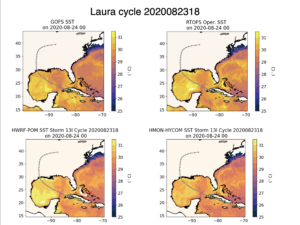
The plots we really wanted to see were the vertical sections. Here we look at the upper 350 m of the water column along the track of Laura from the start of the forecast to landfall. The x-axis is latitude, starting with the south on the left. The white area near 22N is Cuba. The black line on the plot is the 26C isotherm. After leaving Cuba, Laura crosses the warm waters of the Loop Current, then the shallow warm water layer in the central Gulf. The main feature of interest here is the deeper layer of warm water near 26N. This layer is in the northwest corner of the Gulf, the area the hurricane is expected to intensify before landfall. Looking at the surface layer structure, we have long known that GOFS, ROTFS and HMON’s HYCOM will look similar. It is good to see how similar the ocean in HWRF’s MPIPOM is along this track. This is a big step forward with the new HWRF. It moves us to a new level of validation. Our communications used to concentrate on whether the Essential Ocean Features impacting hurricane intensity even existed in the models. Now we are talking about the detailed structure and evolution of the Essential Ocean Features. A big step change.
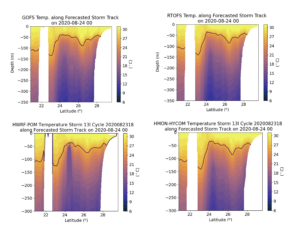
-
The morning of …
Posted on August 26th, 2020 No commentsSome comments from the National Hurricane Center’s 4 am Discussion:
Satellite images indicate that Laura has become a formidable hurricane since yesterday evening. The hurricane has intensified a remarkable 40 kt during the past 24 hours, and there are no signs it will stop soon, with shear remaining low-to-moderate over the deep warm waters of the central Gulf of Mexico.
From the forecast guidance models below, we see good agreement on track on the left, and on the right, operational HWRF and HMON are in good agreement with the intensity increasing to Cat 3. HAFS increases intensity to Cat 4.
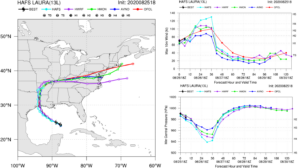
OceansMap has been updated with the 4 am track uncertainty cone. Laura is forecast to track over the relatively warm and fresh surface waters of the northwestern Gulf. Two Navy Gliders are within the track uncertainty cone, ng645 on the right, and ng314 on the left. TAMU glider Stommel is just off to the west in a small warm eddy. The automated morning glider/model comparisons should complete their run soon and we’ll get a look at the profiles from these gliders.
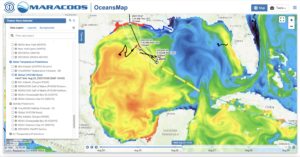
Navy Glider ng314 (left of track) is the first of the three comparison to process. We seem to be getting used to the global models doing well with assimilating the temperature data from gliders that have been deployed in advance of the storm.
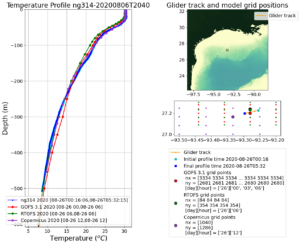
Navy Glider ng645 (right of track) is out. Same image we are getting used to. GOFS is assimilating the glider data nicely, and ROTFS is keeping in step with the NOAA winds. Both US models are doing slightly better than Copernicus in the critical upper 200 m.
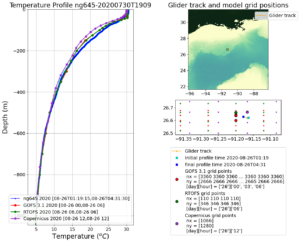
Now the look at salinity. First Glider ng314 on the left. We know salinity is harder – we have no satellite to help us with the smaller scale surface variations. So I expect variability near the surface, and we see it. Still the global models are resolving the Essential Ocean Feature in this region – the all have a surface barrier layer. GOFS and RTOFS even have the barrier layer at the right depth – thats good. Why is the observed surface salinity a bit less, something to come back to and figure out. Horizontal variability – we see a lot of this in the higher resolution oceans under HWRF and HMON. Also, we should track down what caused the deviation of GOFS in the 200 m to 600 m range. It has moved GOFS to slightly saltier values, but ROTFS remains aligned. That means it is likely to do with data assimilated by GOFS in the last 2 days, since RTOFS is always 2 days behind in the assimilation. This is the region of the profiles that we also see impacted by the altimetry. So what combination of altimetry and gliders, and what glider profiles are chosen for the assimilation if important to check. All these decisions have to be made in the implementation of RTOFS-DA that is being tested this summer. We can add another test case to the list.
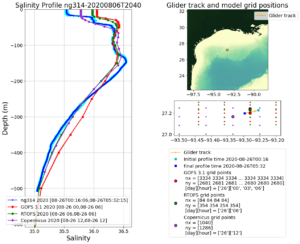
Lets finish with the salinity profile on the right of the track from ng645. Here GOFS is doing fine in the 200 m – 600 m range. This really does narrow the search for improvements we can implement in ROTFS-DA with two gliders in the same storm with different behaviors. But now the upper ocean. The barrier layers are there in all three global models, but how did the Europeans do so well on the salinity in that layer. The US models saw the impact of Marco, a mixing and increase in the surface layer salinity. Maybe the European’s had less change in the salinity during Marco, and now the real ocean is just coming back into agreement with a relatively steady Copernicus forecast? All good questions to check into as we refine the experimental RTOFS-DA, and eventually build the data assimilation procedures for the future ocean model MOM6.
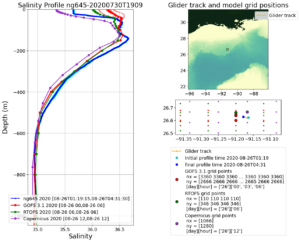
-
The night before …
Posted on August 25th, 2020 No commentsOur friends on the Texas-Louisiana coast are tonight preparing for a significant storm that will hit late tomorrow. Our job is to not to waste this event. Learn as much as we can when these terrible storms do happen so we can help provide more accurate guidance with longer lead time in the future.
Lets look at the ocean conditions the night before. Here we look at the GOFS Sea Surface Temperature (satellite SSTs are obscured by the hurricanes clouds, so we need to look at the models). The most striking feature is the asymmetrical response of the Gulf to this storm that is not even half way across. Here the color bar ranges from 26C to 32C. The entire eastern Gulf has cooled to near 26C. The western Gulf is above average hot, closer to 31-32C. Laura is heading towards the warmer waters of the western Gulf. Also note that the intensification to Major Hurricane occurs just as the storm is making its way across the warm water on the LaTex shelf. Why is this storm forecast to intensify most over this piece of warm ocean? Is it so warm that the shallowness does not matter? Very happy to see what now have 3 gliders in play, two Navy Gliders, ng314 and ng645 in the direct forecast path, and TAMU glider Stommel just to the left.
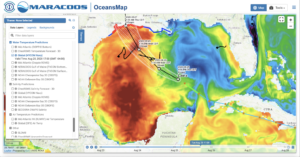
Lets next look at why the eastern Gulf is so much cooler. First we overlay the 5 km NAM winds over the SST, and we see the strongest winds on the right hand side of the Laura as it moves north.
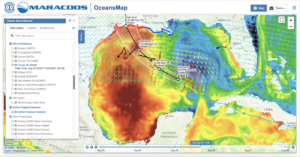
Next pop up the global Wave Watch III waves and we see the largest waves 7 m high or higher are on same right hand side of the Laura as the strong winds. Lots of wind and large waves mean lots of mixing , and a cooler SST.
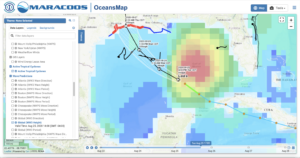
Laura has itself set up this east-west SST difference across the Gulf. But want about salinity, and the impact of Marco? Below is todays GOFS model Sea Surface Salinity (SSS), enhanced to highlight salinities between 34 and 37. Here fresh-salty water distinction is between the northern and the southern Gulf, with the northern coastal Gulf fresher than the regions around it. So the area we are forecasting for the largest intensification is the north west region of the Gulf where we have both the warm western waters and the fresher northern waters.
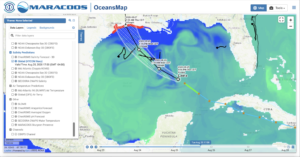
-
Data assimilation vs rapid process evolution
Posted on August 24th, 2020 No commentsAdding this post so that we do not loose track of this event revealed by NG645 as it is passed by Marco.
First plot below is the temperature profile comparisons from this morning. The data assimilative GOFS is closest to the glider temperature profile. There is some cooling in the upper ocean in RTOFS. Recall that RTOFS backs up 2 days in GOFS, pulls the initial condition, and moves forward without data assimilation with the NOAA winds. GOFS is doing data assimilation up to the present. RTOFS relies on model processes to carry the evolution forward for the final 2 days. Hard to say which approach is better based on temperature.
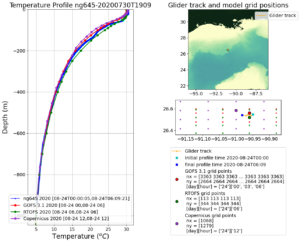
But now lets check the salinity profiles, and the evolution of the barrier layer. Here GOFS (red) kept the barrier layer salinity low consistent with the pre-storm conditions. RTOFS (green) mixed the barrier layer fully consistent with the Navy glider profile (blue) based on physical processes over the last 2 days.
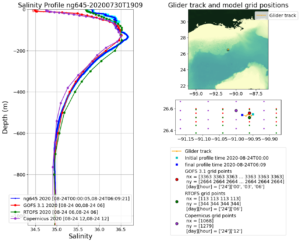
We saw similar behaviors in the data assimilation during Hurricane Michael in the Gulf a couple years ago. Perhaps this is another case where the choice of which CTD profile is assimilated during a period of rapid evolution makes a difference. Its an important time to investigate what we have noticed here, since RTOFS-DA is currently being run in experimental mode.
-
Leaning towards the regional models
Posted on August 24th, 2020 No commentsThe following is cut and pasted from the National Hurricane Center (NHC) Forecast Discussion at 5 am this morning:
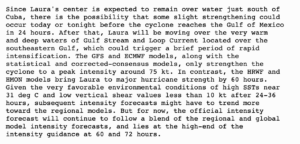
We also started a similar discussion in yesterday’s Hurricane Blog. The two operational regional models are continuing to agree this morning, and NHC may be leaning towards this consensus. Below is what this looks like from the NWS HAFS website. On the left, all the models are in tight agreement on the forecast track of Laura over Cuba, and across the Gulf up until landfall. On the upper right, the differences in the intensity forecast remain significant. The two regional models, HWRF (purple) and HMON (green), now using the same ocean initial condition derived from the data assimilative global GOFS model, still have Laura intensifying at 60 hours to a Cat 3 hurricane. One experimental model (light blue) is consistent with the consensus intensity of a tropical storm until 60 hours, but after 60 hours, instead of rapidly intensifying, keeps Laura as a weak tropical storm. The official intensity forecast from the NHC as described above is shown in red.
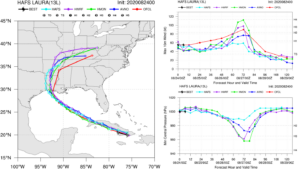
-
A good day for data assimilation
Posted on August 23rd, 2020 No commentsLet’s now look at Navy Glider NG645. Part of the annual Hurricane Glider Picket Line. The glider that is closest to the forecast track of Marco and Laura before the hurricane comes through.
Remember that the Hurricane Glider Picket Line has two purposes. The first purpose is to act in a coordinated fashion to resolve the Essential Ocean Features that impact hurricane intensity in each region that the hurricanes may pass over. This requirement to have a realistic ocean model forecast exists whether there is a hurricane or not, and benefits all users of the ocean model, including hurricane forecasters and models. The second purpose is to have at least one glider, and hopefully more, in place to witness the rapid evolution of the ocean as the hurricane passes. This provides data for the process and sensitivity studies that help improve the forecast models of the future. The two purposes have different sampling requirements, and the gliders have the flexibility for both.
The first plot below is the temperature profiles provided by Navy Glider ng645 compared to the Navy global ocean model GOFS, the NOAA global ocean model RTOFS, and the European global ocean model Copernicus. My immediate impression is that the glider and the data assimilation schemes are doing their jobs. The daily spread in the glider profiles is nearly imperceptible, as is the difference between the US and European models. We see the surface layer of warm water above 26C is well less than 100 m deep, a shallow warm layer as expected based on the Sea Surface Height maps we looked in yesterday’s blog post. Our older textbooks say Marco will cool this layer through vertical mixing and leave a cooler ocean behind for Laura.
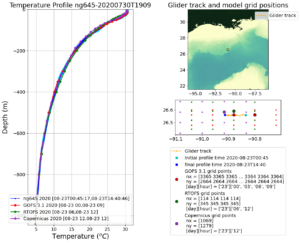
Now let’s look at salinity. Navy Glider ng645 daily salinity profile spread in light blue and the daily average in dark blue are compared to the three operational global models. Again, the differences are imperceptible. All the global models have a proper shape for the salinity profile, and even include a shallow fresh water barrier layer in the upper 40 m. The new textbook says this barrier layer is going to inhibit the mixing, so that Marco will not cool the ocean as much as expected, leaving behind a less cooled ocean for Laura. The Navy glider was out well before the storm, and there was plenty of time for the data to work its way through the system and into the models through the data assimilation system. The ocean model at the beginning of the hurricane forecast value chain, the Navy’s data assimilative GOFS model, could not be more ready. The Navy glider, and the Navy data assimilation into GOFS, is fulfilling the first purpose of the Hurricane Glider Picket Line as described above.
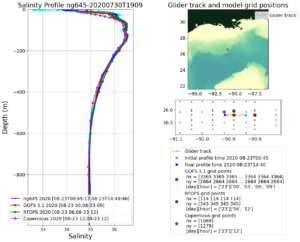
Tomorrow, and throughout the week, we watch Navy Glider ng645 fulfill the second purpose of the Hurricane Glider Picket Line to capture the rapid evolution of the ocean as two hurricanes pass over it.
-
Ocean conditions for Marco and Laura
Posted on August 23rd, 2020 No commentsBoth Marco and Laura are forecast to intensify as they cross the Gulf and approach the coast of Louisiana. Lets check the ocean conditions they are encountering (Marco) or will encounter (Laura).
First we look at Sea Surface Temperature (SST) from the data assimilative Navy GOFS model. Here the temperature scale ranges from 25C to 32C. Marco is already over the Loop Current and Laura will pass over it. Both storms will be crossing over some of the warmest sea surface temperatures in the northern Gulf off the coast of Louisiana. A good contrast in what Marco will do to the deep warm waters of the Loop Current compared to the shallow warm waters of the northern Gulf before Laura passes over them.
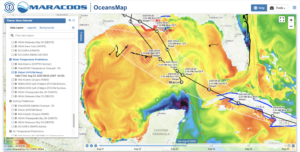
Below is the Sea Surface Salinity (SSS) map for the Gulf, with the color scale going from 34 to 37. The low surface salinity waters of the Mississippi River are evident on the Texas, Louisiana, Mississippi, Florida shelf. Our experience in the Caribbean during Isaias reminds us that the low salinity barrier layers inhibit mixing, resulting in less cooling of the surface waters, and greater potential to intensify the hurricanes.
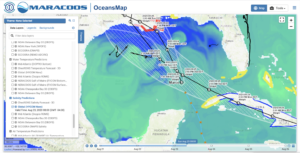
Another natural experiment on the coupled ocean-atmosphere response to 2 hurricanes will unfold over the next few days. In our textbooks, we are told that the first hurricane is supposed to mix and cool the waters so the second hurricane has less warm water to promote intensification. But the warm water in the south is the deep Loop Current that does not cool rapidly. And the warm water is blanketed by a low salinity barrier layer that inhibits mixing. The storms will be passing by Navy Glider NG645 which has been on station this season as part of the annual Hurricane Glider Picket Line. Again, much more to learn if we form the research teams to look.
-
Laura – another science storm for 2020
Posted on August 23rd, 2020 No commentsThis morning’s NHC forecast calls for Laura to continue tracking from Hispaniola along the spine of Cuba, enter the warm 31C waters of the Gulf and intensify as it moves across the Gulf towards landfall in Louisiana. With the new HWRF v13.0.0 moved to operational status on Aug 5 at 12Z, the focus of our discussions changes. All operational and many experimental models are now using the same ocean, the high quality representation derived from the Navy’s data assimilative GOFS, which is used to initialize the NOAA global RTOFS that layers in the NOAA global winds, which is then used to initialize the ocean models coupled to HWRF, HMON, and FV3 (in HAFS v0.1.a). Lets begin by looking at how this high quality ocean forecast may be influencing the hurricane forecasts.
Yesterday was a remarkable day for Laura hurricane forecasts. We noted there were significant differences in track between the 3 models (HWRF, HMON, and HAFS (v0.1.a)), and that there were significant differences in the resulting intensity as Laura entered the warm Gulf. HWRF took a more easterly track that resulted a rapid intensification to Cat4, HMON and HAFS tracked more towards Texas and was forecast to stay near or below Cat1. But how much of the difference in intensity forecast is due to the different atmospheric models, and how much is due to the different atmospheric and ocean conditions encountered along the different tracks. It is hard to separate the two. You either want the same model along two different tracks to look at the influence of track differences, or different models along the same track to look at model differences.
That makes today’s forecasts for Laura an even more remarkable day for hurricane science. Below are the forecast model results from the NOAA NWS HWRF website. Here on the left we see the HWRF (purple) and HMON (green) forecasts follow almost the exact same track into Louisiana until just before landfall. On the upper right, we see the intensity forecasts. Both HWRF (purple) and HMON (green) are predicting the rapid intensification event at the exact same time, 72 hours into the forecast. Both have it rapidly intensifying to Cat 4. Different models, same track, same ocean, same intensity forecast.
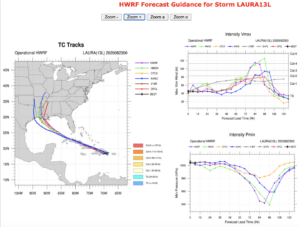
Now lets check in on one of the experimental models in HAFS, specifically version 0.1.a that is coupled to the same ocean as HWRF and HMON. Below on the left, HAFS in light blue is also crossing the Gulf on essentially the same route as HWRF and HMON, also landfalling in Louisiana, but a bit west of the others. But HAFS keeps Laura below hurricane strength the entire time.
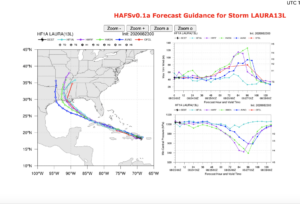
This example illustrates the challenges of hurricane forecasting. We are 4 days before the forecast landfall in Louisiana, and with Laura, we see the models converging on a similar solution for track, but still diverging on the solution for intensity. We see that for Laura, the different HWRF and HMON models, now using the same ocean since Aug 5, converge to the same intensity forecast once the track converges. This was not the case as recently as Isaias, the storm just before Aug 5 when HMON used the high quality ocean derived from the Navy’s data assimilative GOFS, and HWRF was still using climatology.
We are learning much from this hurricane season. We are seeing improvements along the entire value chain, from the observing systems we deploy, to our ability to assimilate the data, and on to the coupled atmosphere-ocean models used for the hurricane models. And we are seeing what the NWS annual reviews have been saying for years, that we continue to make progress on track forecasts, but that improvements to intensity forecasts lag. We desperately need the research to figure out why. We have a vast pool of researchers at NOAA, the Navy, in universities and in industry that are willing to contribute, and we have the regional expertise already assembled and coordinated through U.S. IOOS and the OAR Cooperative Institutes. It is time to expand the Hurricane Forecast Improvement Program (HFIP) across agencies, across sectors, and across disciplines. If the answer is HFIP is already doing this, my question will be the same as it has been since Sandy, are we doing enough?
-
Laura and the Loop
Posted on August 22nd, 2020 No commentsThe NHC forecast discussion from this morning nicely summaries the expectations for Tropical Storm Laura as at moves into the Gulf of Mexico over the weekend. The intensity forecast approaching the Gulf is highly track dependent. If the track is mostly Hispaniola and Cuba, the rugged terrain favors keeping the intensity low. If the track is more over the water, the warm ocean favors an earlier increase in intensity. The larger intensity uncertainty occurs when Laura enters the Gulf.
For the operational models in the Gulf, HWRF track is more to the east, landfalling in MS and has a significant intensity increase to Cat 4 crossing the Gulf. HMON has a track more to the west and keeps the intensity relatively steady below Cat 1 until approaching landfall in TX. The new experimental HAFS model favors a track similar to HMON but with an intensity that never increases beyond tropical storm.
https://www.emc.ncep.noaa.gov/gc_wmb/vxt/HMON/tcall.php
It has been a season for science storms. What this storm does after it enters the Gulf will be a test case for future model improvements. Part of those studies will be to better understand the impact of the ocean on intensity. As Laura enters the Gulf, it will be crossing the Gulf’s most significant Essential Ocean Feature for hurricane intensity, the Loop Current. We start with a look at the Loop Current state in the two data assimilative global ocean models, the Navy GOFS and European Copernicus. Maps of Sea Surface Height (SSH) are plotted below from both models.
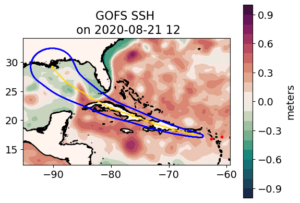
In the figure above and below, the Loop Current is high (red) sea surface height area that enters the Gulf between Yucatan and Cuba and then leaves the Gulf between Florida and Cuba. Comparing the two models we see the Loop Current position is very similar, with some slight variations in the east-west width. The models also agree that there is warm eddy north of the Loop Current and just south of Mississippi that will likely play a role in the intensity forecasts. We see the eastern path of Laura towards MS is near this warm water feature, while the western path towards TX is over more cold water (low SSH in green) features until you approach the coast of TX, when HMON says the storm could intensify.
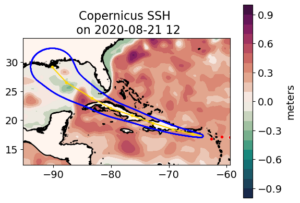
In one more plot, that warm eddy we looked at during Cristobal that was along 90W. It is now in the western Gulf centered around 94W. It is shown in the GOFS SSH plot below and is to the west of the forecast track cone for Marco.
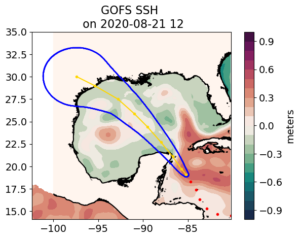
Looks like the focal points for the oceanographers for these storms will be the details of the Loop Current shape and the warm eddy south of Mississippi.
-
Two storms approach the Gulf
Posted on August 21st, 2020 No commentsTwo tropical storms are approaching the Gulf of Mexico. Tropical Storm Laura is currently over the Caribbean’s Windward Islands and is forecast to travel along the Greater Antilles along the cooler northern side of the Islands and into the very warm Sea Surface Temperatures (SST) of the Gulf were it is expected to intensify into a hurricane. Fourteen is moving northward over the warm waters of the western Caribbean towards Yucatan, then into the very warm Gulf where it is expected to intensify to a hurricane. By Tuesday next week we could have 2 hurricanes intensifying in the Gulf and about to be making landfall along the northern Gulf Coast. The very warm ocean features of the Gulf will be something to watch over the next few days. Here we are looking at the general ocean features in the Navy’s data assimilative Global Ocean Forecast System (GOFS), the start of the value chain for 3 US coupled hurricane forecast models, the operational HWRF and HMON as well as the experimental HAFS with the new FV3 core. The temperature range of the SST color bar is 25C to 31C.
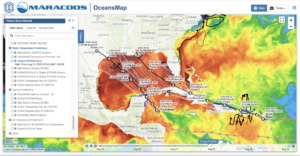
In parallel, we also watch for the low salinity barrier layers due to freshwater inputs from rivers. They are viewed below in the Sea Surface Salinity (SSS) fields also derived from the data assimilative GOFS. We see the fresh water barrier layers in the eastern Caribbean due to the Amazon and Orinoco, and the fresh water spread along the northern Gulf from the Mississippi. Here the color bar range is for salinities from 34 to 37.
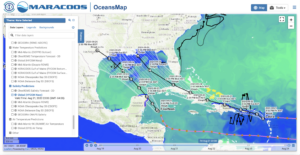
So two storms entering the Gulf this weekend, both expected to intensify into hurricanes over the Gulf’s warm water early in the week, and both will be passing over the Mississippi’s freshwater barrier layers



